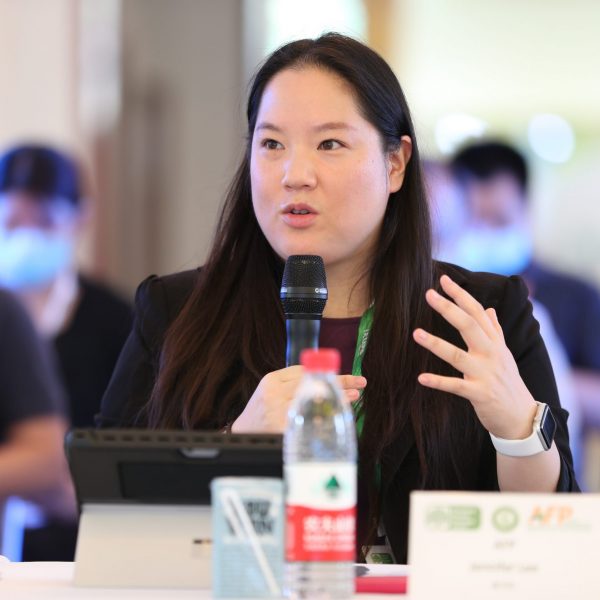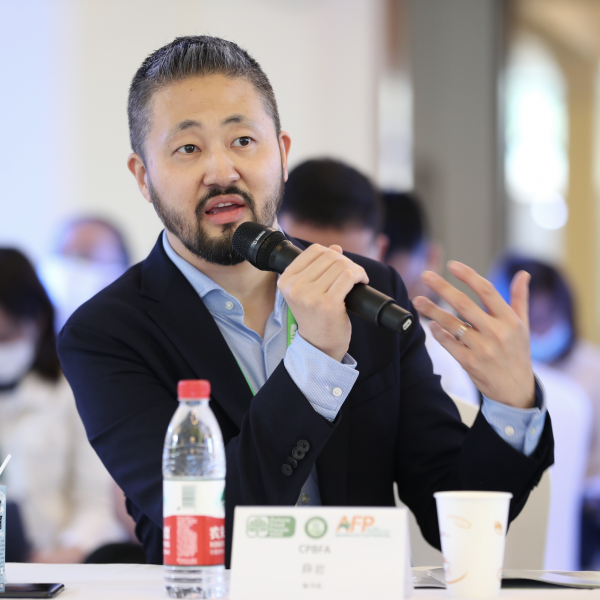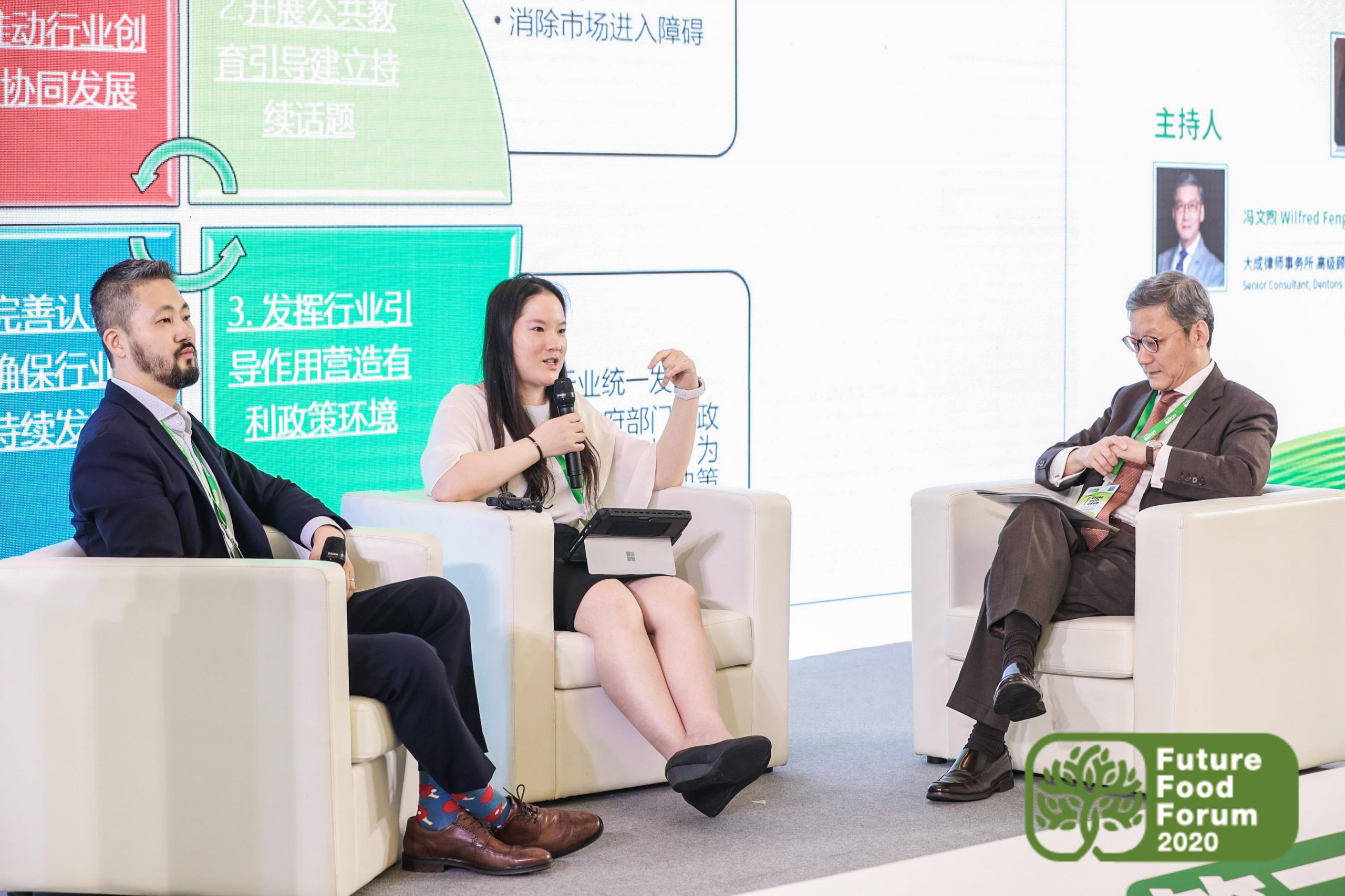Protein Innovation Plants the Seeds of Collaboration

Jennifer Lee is founding Executive Director of the Agriculture and Food Partnership (AFP), based at AmCham China. AFP is a private-public partnership (PPP) for food and agricultural cooperation that links international and Chinese public, private, and NGOs to advance mutual food security, food safety, and sustainability through the promotion of cooperative activities and optimal practices. Jennifer previously held senior positions at the US Department of Energy and the US Department of Commerce in Washington DC and across China creating PPPs across many industry sectors, including energy and environmental technologies. Jennifer was also the primary China lead in coordinating public-private cooperation in the execution of the landmark $150m Clean Energy Research Center launched by Presidents Barack Obama and Hu Jintao.

Ryan Xue leads the China Plant Based Foods Alliance (CPBFA), which he co-founded in 2018, and one of the first organizations to represent the plant-based foods and protein innovation sectors in China. The CPBFA is backed by the State Food and Nutrition Consultant Committee and numerous government organizations in China. Ryan has a particular interest in the factors that influence consumer attitudes towards emerging protein sources. He co-founded AgFood Future, which assists the public and private sectors to address sustainable development challenges and enhance global agri-food low-carbon transformation.
Jennifer Lee, AFP: Currently in China, protein innovation is gaining interest and the CPBFA is one of the pioneers leading this movement. Our two organizations – the AFP and the CBPFA – have been collaborating on the critical issue of agri-food sustainability. Ryan, do you want to begin by talking a bit about why our two organizations are partnering, provide some background on the CPBFA, and share some insights on the protein innovation trend and its development over the past three years in China?
Ryan Xue, CPBFA: The China Plant Based Food Alliance (CPBFA) was originally a spinoff of the State Food Nutrition Consulting Committee. We officially launched in 2018, with around 30 founding members. Over the past few years, we’ve seen a boom in memberships, from 50 to 120 in 2019. When Beyond Meat went public in May 2019, we began to see even more interest from Chinese domestic companies. Currently we have 260 members and we’re still growing. Our membership is diverse, and we are seeing financial institutions increasingly interested in our work – we have at least 50-member companies in this sector. Recently, European and North American investors have become extremely interested in APAC and China. Our mission is to promote protein innovation in China. To achieve this, we work closely with the public and private sectors to facilitate protein innovations aligned with organizations’ strategies and incentivize behavior change.
Lee: Recent investment points to where the opportunities lie. We are seeing investors come to China and we’re seeing the interest in the Chinese markets as well. We have often said before that China is in a unique market to spur protein innovation. The China market is primed at both a consumer and manufacturing level for this. China already has 1,000 years of tradition in manufacturing and eating diverse protein sources including, soy proteins, tofu, and pea protein – and has a history of eating more innovatively than most Western countries. That history makes this topic even more relevant within China, and provides China with an important chance to have a global impact.
When the AFP and CPBFA were first introduced, protein innovation was something we had been hearing about in the industry for a couple of years, but at AFP we didn’t yet realize how quickly it would move to the forefront for our Chinese partners and members. There has been interest at a company level in order to reach low carbon goals, but I also think COVID-19 accelerated this shift in the industry.
Typically, when we talk about low carbon, the agriculture and food industry looks at how we use land and water, and how livestock is managed. However, we have also found real opportunities in next-level protein innovation, and that’s why we ended up working so closely together. We’ve worked to bring Chinese and US industry and governments together. This is so important when you have an emerging field, because there is not only the issue of technology and investment, but also how to regulate this new field. A lot of important work has been done on regulations by our organizations this past year, and it’s really brought together the complementary strengths of our two networks.
The CPBFA has brought expertise on the China market and innovation in the agriculture, plant-based foods, and protein sectors. The AFP has brought US and Chinese partners from public and private sectors that have been working together for eight years now to reach China’s goals for food safety, security, and sustainability.
Xue: Another reason for the growing interest is public health. In addition to COVID-19, there are also things like the African swine flu epidemic of 2018, which not only affected human health, but also wiped out at least 40% of China’s hog supply. Awareness of the relationship between food security, food affordability, and sustainability is growing. Of course, climate is a huge issue; many people initially think of only the energy sector, but now that focus is shifting towards agriculture and food. It’s a complex issue to bridge agriculture and food with climate but, in simple terms, there is a need for three or four key sectors to undergo a transformation. It’s not a change, it’s a transformation. We’re combining the protein innovation viewpoint with the more traditional agriculture supply chain perspective to bring improvements and opportunities to the whole industry.
Lee: A frequent discussion we have is how to upgrade traditional agricultural food value chains – how to green the supply chain. While this is necessary, we’re most excited about how new technologies can work within existing supply chains. There is a lot of connection between clean agriculture and low carbon. Two of the biggest questions now are one, how can we utilize breakthrough technologies from different areas in the agriculture food supply chain? And secondly, how could that help to achieve even more ambitious sustainability goals?
Xue: In the past, the timing between the US and China never worked out. But now, as governments reach global agreements on carbon neutrality, we’re going to see this experiment play out. We cannot predict the outcome and that’s why we need to form new partnerships and collaborate on strategies to form industry guidelines. It’s not like changing a tire, it’s not about finding a replacement, it’s about collectively upgrading the entire vehicle.
The issue we’ve chosen to tackle is protein, which in total, accounts for more than 50% of emissions in the agriculture-food supply chain. We are working to accelerate the low-carbon transformation within the global food system. The good news is that these solutions are becoming cheaper, and when they reach a certain price point, that’s when we’ll see real change.
Lee: What it comes down to is how to bring different stakeholders together to be effective and efficient? That question requires us to bring everyone to the table. It’s something unique to China to be able to get the different sectors to sit across the table from one another and talk about sustainability together. A lot of the time in the US, you’ll find yourself caught in an either-or matrix – the discussion is about only vegan, pure plant-based sources, or 100% meat, and so both dialogue and innovation stop there. However, in China, there is a much more open conversation happening. Earlier this year, we were able to bring together organizations from both the US and China’s meat industry and protein innovation sectors. Opening up that conversation is a massive opportunity and we look forward to introducing more stakeholders at an executive roundtable at the end of 2021. It will be a unique opportunity for two of the largest producers and consumers of protein to engage in the overall sustainability issue.
Xue: We bring collaboration to these different stakeholders. We also try to encourage long-term thinking. Instead of simply creating a new product for the existing system, let’s come up with new creative ideas.

Ryan Xue
Executive Director
of CPBFA
Lee: Companies are looking for ways to get more engaged. One example of our work is facilitating discussions and dialogues with regulators, to better define the roles of standards and certifications in this topic. Our biggest challenge is bringing stakeholders together to work on solutions that will change food systems. I try to explain to people the impact of this work by saying it is to the agriculture food industry what solar panels are to the energy sector. The agriculture-food chain’s solar panels and smart grid so to speak, have yet to be created. Therefore, the potential for impact is limitless.
Xue: Many decision makers have concluded that they need to act. They want to lead their organizations towards more sustainable and richer SDGs and ESGs. We can provide insight and establish a framework, quantifiable models, and outcome-based industry guidelines/metrics to facilitate that transformation. I want to encourage more Chinese organizations to participate. Sustainability is currently a rare area of common ground where the US and China can work together.
Lee: Absolutely. A common question is whether the agricultural food sector is getting involved in sustainability. And what is the opportunity for contribution of the sector in the wider climate dialogue?
Xue: The numbers vary, but, the overall agriculture and food chain contributes at least 25% to global carbon emissions. Both the US and China contribute substantially to that number. Agriculture-food is an issue people are not as familiar with, but one that contributes greatly to overall emissions. Protein can contribute to at least 50% of those agricultural and food emissions, so protein innovation provides a path to greatly reduce overall emissions.
Lee: Another key number to consider is China’s appetite for meat, and how quickly it’s growing. Previously, the 1.3 billion people in China were not consuming as much protein, but estimates now indicate that by 2026 China will be responsible for 27% of the world’s industrial farmed livestock. Additionally, China is now the world’s largest agriculture importer and exporter. If you factor in all these considerations, the work we’re doing is ultimately also about global food security.
When we’re working with different companies, evaluating how sustainable they are, beyond greening their supply chains, we’re focused on exploring opportunities. Instead of simply cutting emissions, we consider how to create whole new supply chains and product areas. We facilitate pilots, tech transfer, and commercialization to accelerate the low-carbon transformation.
Xue: You mentioned the either-or mentality that is more common in North America. In China, we are looking for a more inclusive mentality. A traditional Chinese diet is based around the idea of balance between vegetables and different proteins. By promoting more diverse sources of protein, we hope we can achieve that balance.
Lee: Another question often asked is how effective is the work that we’re doing going to be? What is the role of customers and consumers? At the end of the day, you really need all the players. How the public sector will set goals, incentives, and regulations is important, and we work with relevant government partners to help us promote a healthy regulatory environment through collectively drafted standards and policies. However, industry is also key because that is where we’re looking at to create new products. Industry is the best way to cut emissions exponentially.
The education of consumers is important. Our educational outreach creates understanding and ongoing discourse on protein innovation and low-carbon/sustainability issues. We have seen consumers confused about what exactly constitutes “alternative” protein. The answer isn’t necessarily just, “We’re going to call it meat.” We can create and educate consumers on a whole new category of products. We want to move away from the mindset of 100% vegan or 100% meat-eater. Innovation can bring together blended products, which is when you combine animal and plant proteins to create a new product. Who would say no to lower fat, lower salt, increased nutritional value, and a lower carbon footprint from their food?
Xue: Exactly! It’s what’s better for each of us, as well as better for the world. Between the US and China, there’s the opportunity for both traditional protein and new innovations. As public-private partnerships, we both believe that government at different levels can partner with industry and the research community to be effective in promoting policies and spurring innovation. It’s top-down and bottom-up all working together.
Lee: We welcome new partners to bring their own valuable experience to the table. There are now unprecedented opportunities for the Chinese and international industry, R&D community, start-ups, investors, and government partners to collaboratively bridge, educate, guide, chart and deploy AgFood breakthroughs for the low-carbon transformation.
To learn more about AmCham China’s US-China Agriculture and Food Partnership go to https://www.amchamchina.org/us-china-agriculture-and-food-partnership/

This article is from the AmCham China Quarterly Magazine (Issue 2, 2021). To access the entire publication for free, sign up on our member portal here.

